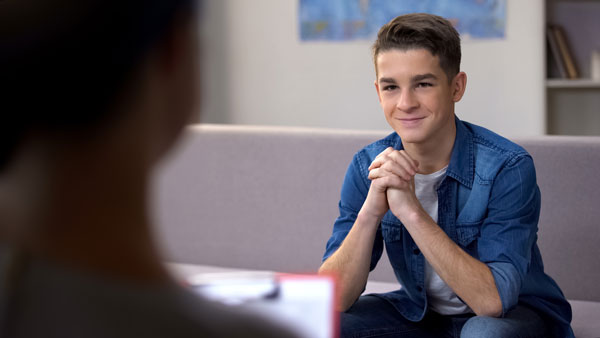Do I have ADHD?
Symptoms of Attention-Deficit Hyperactivity Disorder
Attention-Deficit Hyperactivity Disorder (ADHD) is one of the most common neurodevelopmental disorders of childhood. ADHD symptoms start before the age of 12 and can be noticeable in children as young as 3 years old. Common symptoms or signs to look for if you believe your child may have ADHD include:
- Fidgeting or squirming
- Frequent daydreaming or lack of attention
- Excessive talking
- Becoming distracted by small details or unrelated thoughts
- Difficulty getting along with others in social situations
It is common for children to have behavioral or focus issues at one point or another, but in children with ADHD, these issues will:
- Be more severe
- Last for a prolonged period of time as the child gets older
- Occur more often than normal
- Negatively affect the child socially in school or other activities
Different types of ADHD
Three types of ADHD
There are three types of ADHD that are categorized by their symptoms.

Predominantly Inattentive - The individual has trouble focusing on a specific task, gets distracted easily, or struggles to follow details or listen to directions. This person may easily forget daily routines, tasks, or directions.
Predominantly Hyperactive/Impulsive - The individual is constantly moving, tapping, or speaking even during inappropriate times. Someone who is impulsive may interrupt others, have trouble following directions, and may feel restless from their constant movement and activity.
Combined - The individual has a mixture of the symptoms mentioned above.
When is the right time to seek professional help?
Diagnosis
Hyperactivity, as well as inattentiveness are both very common in children and just because your child is extra hyper or shy and easily distracted does not mean that they should be labeled as having ADHD. So how do we know when to see a doctor or specialist for a diagnosis if we are concerned about them having ADHD?
First off, there is no single diagnosis to test for ADHD. Making a diagnosis will most likely include: A medical examination, interviewing those around the patient to gain more information, possible referral to other specialists, as well as the use of the ADHD criteria checklist to rate the patient on the scale.
According to the National Institute of Mental Health (NIMH), “For a person to receive a diagnosis of ADHD, the symptoms of inattention and/or hyperactivity-impulsivity must be chronic or long-lasting, impair the person’s functioning, and cause the person to fall behind typical development for his or her age. The doctor will also ensure that any ADHD symptoms are not due to another medical or psychiatric condition. Most children with ADHD receive a diagnosis during the elementary school years. For an adolescent or adult to receive a diagnosis of ADHD, the symptoms need to have been present before age 12.”
How do I treat ADHD?
There are many different treatments and options to help someone with ADHD:
Medications
- Stimulants - The most common medication for ADHD is described as a “stimulant” and it works by changing the brain’s chemicals to help better control symptoms.
- “Non-stimulants” may also be used to treat ADHD if stimulants have negative side effects or are ineffective to the patient.
- As with any medication, there are risks and side effects, which is why working closely and collaboratively with your doctor or specialist is important while trying to treat ADHD. Some people will use no medication, one of the types, or even a mix of different medications.
Therapy and Training
- Behavioral therapy can help an individual work through and learn about their own different behaviors. Children can be taught different social skills and acceptable behaviors for them to practice.
- Parent Training - Parents can also be trained on how to better handle children with ADHD. Parents can learn how to reward positive behaviors and challenge negative behaviors in their child.

Lifestyle Changes
Being healthy, regardless if a child has ADHD or not, is important for everyone and there are simple steps that can be taken to keep your children and family healthy.
- Healthy Food - This includes plenty of fruits, vegetables, and lean proteins while avoiding highly-processed sugary snacks and foods.
- Stay Active – Getting your child active through exercise or an organized sport is a great way to keep them healthy, while also helping them socially.
- Sleep – Getting the right amount of sleep each night is important for a person’s development and overall health.
Everyone is different and reacts differently to different types of treatments, which is why it takes time to find the right way that works for you and your child. Always listen to the doctor’s suggestions and be patient.
How do I live my life with ADHD?
Living with ADHD can be confusing and challenging for both the parent as well as the child with ADHD. There are many treatments, resources, and organizations out there to help you better understand and work with ADHD.
Working closely with your doctor, leading a healthy lifestyle, as well as keeping things organized for your child can help. Children and adults with ADHD benefit from having structure, routines, and organization throughout their day.
Resources
If you’re interested in learning more about ADHD, you can refer to the CDC’s webpage filled with infographics, statistics, and articles on ADHD.
Sources:
https://www.cdc.gov/ncbddd/adhd/index.html
https://www.mayoclinic.org/diseases-conditions/adhd/symptoms-causes/syc-20350889
https://www.nimh.nih.gov/health/topics/attention-deficit-hyperactivity-disorder-adhd/index.shtml